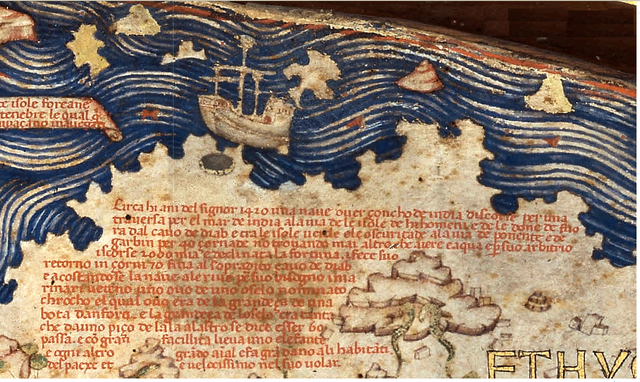 |
This is a file from the Wikimedia Commons. Information from its description page there is shown below.
Commons is a freely licensed media file repository. You can help.
|
Summary
Portion of the Fra Mauro World Map (1450). Source: Piero Falchetta "Fra Mauro's World Map".
Text (Italian) (10, A 13):
- "Circa hi ani del Signor 1420 una naue ouer çoncho de india discorse per una trauersa per el mar de india a la uia de le isole de hi homeni e de le done de fuora dal cauo de diab e tra le isole uerde e le oscuritade a la uia de ponente e de garbin per 40 çornade, non trouando mai altro che aiere e aqua, e per suo arbitrio iscorse 2000 mia e declinata la fortuna i fece suo retorno in çorni 70 fina al sopradito cauo de diab. E acostandose la naue a le riue per suo bisogno, i marinari ubitch uno ouo de uno oselo nominato chrocho, el qual ouo era de la grandeça de una bota d'anfora, e la grandeça de l'oselo era tanta che da uno piço de l'ala a l'altro se dice esser 60 passa, e con gran facillità lieua uno elefante e ogni altro grando animal e fa gran dano a li habitanti del paexe et è uelocissimo nel suo uolar".
Henry Davis gives this translation on his maps website:
- "About the year of Our Lord 1420 a ship, what is called an Indian junk [Zoncho de India], on a crossing of the Sea of India towards the Isle of Men and Women, was driven by a storm beyond the Cape of Diab, through the Green Isles, out into the Sea of Darkness on their way west and southwest. Nothing but air and water was seen for forty days and by their reckoning they ran 2,000 miles and fortune deserted them. When the stress of the weather had subsided they made the return to the said Cavo de Diab in seventy days and drawing near to the shore to supply their wants the sailors saw the egg of a bird called roc, the egg being as big as a seven gallon cask, and the size of the bird is such that from the point of one wing to another was sixty paces and it can quite easily lift an elephant or any other large animal. It does great damage to the inhabitants and is very fast in its flight".
Fra Mauro map has a label "Diab" on a region of South Africa which is either the Cape Peninsula or Madagascar.
"Isle of Men and Women" or "Male and Female Islands" (Imangla and Inebila) are two semi-mythical islands described by many early Arab travel narratives. Marco Polo places them in the Arabian Sea some 500 miles south of Makran (now a coastal region in Pakistan) in the neighbourhood of Socotra. Fra Mauro places them south of Zanzibar. Other early travelers and cartographers proposed locations in Southeast Asia, as far east as Singapore. (Early mapping of Southeast Asia, Thomas Suárez, 1999)
"Green Isles" is an old term for Cape Verde.
The fragment discussing the 'roc' is possibly an exaggerated reference to extinct "elephant birds", which lived on Madagascar until some time before the 17th century.
Licensing
| Public domainPublic domainfalsefalse |
 |
This image (or other media file) is in the public domain because its copyright has expired.
This applies to Australia, the European Union and those countries with a copyright term of life of the author plus 70 years.
 You must also include a United States public domain tag to indicate why this work is in the public domain in the United States. Note that a few countries have copyright terms longer than 70 years: Mexico has 100 years, Colombia has 80 years, and Guatemala and Samoa have 75 years, Russia has 74 years for some authors. This image may not be in the public domain in these countries, which moreover do not implement the rule of the shorter term. Côte d'Ivoire has a general copyright term of 99 years and Honduras has 75 years, but they do implement the rule of the shorter term. You must also include a United States public domain tag to indicate why this work is in the public domain in the United States. Note that a few countries have copyright terms longer than 70 years: Mexico has 100 years, Colombia has 80 years, and Guatemala and Samoa have 75 years, Russia has 74 years for some authors. This image may not be in the public domain in these countries, which moreover do not implement the rule of the shorter term. Côte d'Ivoire has a general copyright term of 99 years and Honduras has 75 years, but they do implement the rule of the shorter term.
|
|
This file has been identified as being free of known restrictions under copyright law, including all related and neighboring rights.
|
File usage
The following pages on Schools Wikipedia link to this image (list may be incomplete):
SOS Childrens Villages aims to make Wikipedia suitable for young learners. SOS Children's Villages works in 133 countries and territories across the globe, helps more than 62,000 children, and reaches over 2 million people in total. There are many ways to help with SOS Children.



